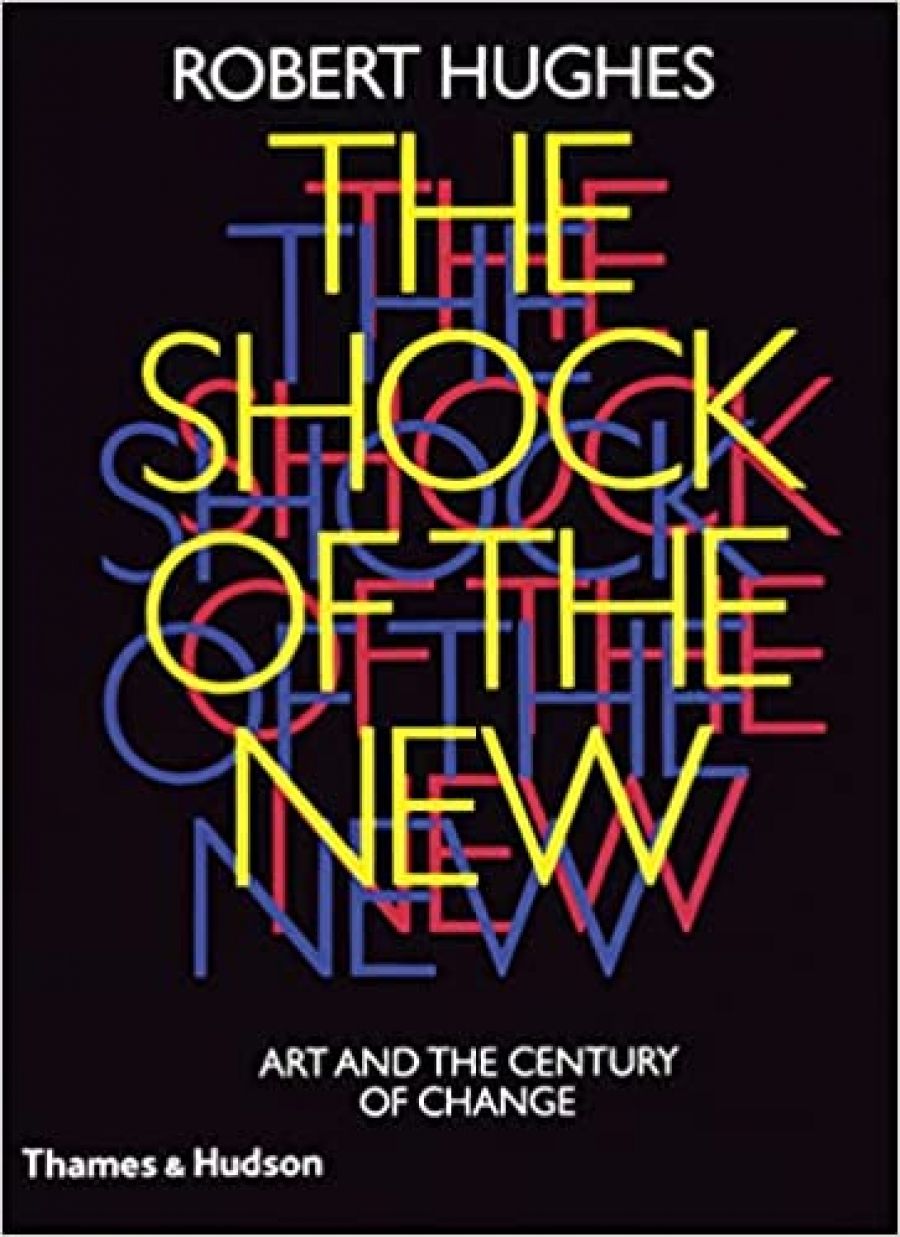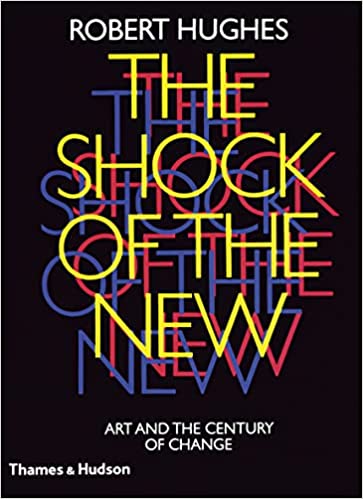
- Free Article: No
- Contents Category: Art
- Review Article: Yes
- Article Title: The Modern Imagination
- Online Only: No
- Custom Highlight Text: Turn The Shock of the New over and on the back cover Robert Hughes stands in a mirrored room, looking out at the spectator, infinitely reflected in a light filled glass box that looks like one of Portman’s new hotels. The choice of photograph is a key to Hughes and the pages within, for in the text, Hughes describes this Mirrored Room by Lucas Samaras as:
- Book 1 Title: The Shock of the New
- Book 1 Biblio: British Broadcasting Corporation, 423 pp
- Book 1 Cover Small (400 x 600):

The Shock of the New covers a brief period in the history of art – the past one hundred years, and through it Hughes guides us with a confidence dented only by the doubts he holds for late Western civilization.
Hughes starts off by announcing that his mammoth project sent him over a quarter of a million miles, and ate up three years of research, writing and filming. It seems heavy on mileage, and light on time, but then Hughes has been at it for a long time. Over twenty years ago he started as critic for the Sydney Sunday Mirror, then Nation and by 1966 London Magazine. In Australia, he made his name with The Art of Australia, published when he was 28, and which already gave a good indication of his fearless swashbuckling style coupled with an ironical delight in knocking the great from their pedestals of fame. Hughes here, as never before, is the master of the epigram and the one-line thought provoker. In those fifteen or so years since Hughes left Australia, he has clearly made it; Time art critic for ten years and now television star. In America, The Shock of the New has the highest ratings of any program, and it is rumored that Hughes has been offered a contract from Hollywood to star in a feature film. A Kenneth Clark minus the leather elbow patches, Hughes clearly sees himself as the inheritor to Clark’s Civilization, but with a flamboyant style emphasized by his penchant for white linen suits and fedoras.
The Shock of the New is no ordinary art book, but a weighty document which fattens up and fills out the eight television programs presented by the BBC. At the end of May, Australian viewers will join the Americans and English in their exposure to the rise and fall of modernism featured across the globe from Brasilia to Las Vegas, filmed in his New York apartment or as he is being chauffeured around the Place de La Concorde in tribute to the Futurist Marinetti.
Hughes believes that Modernism that orthodoxy which has nourished art since 1880 is finished. He sets out to prove it with another orthodoxy, that of ‘social history as seen through the lens of art’. Taking the image of the Eiffel Tower as a metaphor for the techno-logical change which paralleled modern-ism, Hughes hits us with his punchline: ‘The most spectacular thing about it was not the view of the Eiffel Tower from the ground. It was seeing the ground from the Tower.’ The image comes close to being a straight lift from Roland Barthes last book of essays, The Eiffel Tower where he used it as a sign which could signify everything: glance, object to be seen and to see from. Hughes grabs the metaphor and reshapes it into the formalist notion that flatness the way the street looked from the Tower – was the one characteristic which defined Modernism.
Hughes’ approach of art as part of social history makes for spectacular television with its quick cuts from one remote place to another. Flashes of the Eiffel Tower, Hitler's reviewing stand at Nuremberg. Matisse, the Hilton Flamingo, beach scenes and Land Rovers, Saturn V, Leger, and Rauschenberg’s Florida studio all mesh together to create an explosive sense of excitement. He takes a separate theme for each program and chapter. The first, The Mechanical Paradise is the clincher, where the whole story is laid out before us. Art responded to, rather than precipitated change, and the machine was the catalyst which landed both art and its makers solidly in the modern age.
Diving into these pages, one comes up with the conclusion that Hughes is best when he's opinionated and when he speculates on what art used to do and what it does now. And he's at his weakest when actually talking about specific works of art, as though the viewer/reader might lose interest with complex images. Part of the problem inherent in a book like this, is that its initial impetus is the television program so from the outset there is the double bind of two kinds of audience. Long-winded ideas have no place on the box, leading Hughes producer to complain, ‘It's a clever argument, Bob dear, but what are we supposed to be looking at?’ The answer, is the book, expanded five times beyond the program commentary.
This is not potted art history although Hughes perpetuates some old myths (Pollock’s drip paintings are like late Monet) which seem to be culled from old issues of Artforum. It's really a history written for the visual requirements of the television with its ability to quickly juxtapose images and make wild comparisons. I can't read the text without also hearing Hughes’ voice and seeing him casually leaning on a Caro in a Panama hat. The book is not a script, but it still has the feel of a polemic written for another medium. Yet because of its argumentative stance, it streaks ahead of similar contemporary art histories aimed at a general audience; Norbert Lynton’s recent The Story of Modern Art, H. H. Arnason's tiresome A History Of Modern Art, or Herbert Read’s antediluvian Concise History of Modern Paint.
Like a big exhibition of Chinese archaeological finds, or a show of crown jewels, this book and the accompanying programs will appeal to the popular imagination and may even convince its audience that contemporary art and culture is more than the domain solely of an elite. ‘Much of the myth of modern art was created by packaging’, says Hughes in reference to Marinetti. Hughes can package art for a mass television audience better than anyone and by shattering the myth of art as a rarefied practice available to the few, he provides his greatest service.


Comments powered by CComment